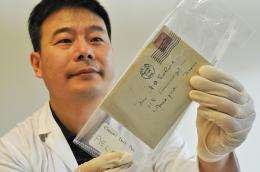Amelia Earhart - DNA research targets mystery

Research set to begin in a Simon Fraser University forensic lab could produce the first DNA profile of aviation's most celebrated woman, Amelia Earhart – and provide new clues about her disappearance more than 70 years ago.
Working from four hand-written letters attributed to the famous pilot, SFU forensic scientist Dongya Yang hopes to extract DNA found in the saliva used by Earhart to seal the letters. His findings could help shed light on recent claims that bone fragments found on a South Pacific island belong to Earhart.
The pilot and her navigator disappeared while flying over the Pacific Ocean in an attempt to fly around the world at the equator in 1937.
SFU health sciences student Justin Long contacted Yang to see if the forensic specialist could use his ancient DNA expertise to study the letters. They are part of a large collection of nearly 400 letters given to his grandfather, Elgen Long, by Jean L. Backus, who used the letters to write the autobiography Letters to Amelia.
Elgen Long, considered an Amelia Earhart scholar, kept a handful of the letters, including one that was later addressed to him by Earhart’s sister, and in 1984 donated the rest to the Schlesinger Library at Harvard University.
Justin says his grandfather spent more than three decades researching facts leading up to Earhart’s final moments.
“The letters he kept are personal – one was written by Amelia on airline letterhead while waiting for a flight – so we can be fairly certain that she is the one who sealed the envelopes,” says Justin, whose PR and design agency ACG Corp, is partially funding the research.
The letters had all been opened at the sides of the envelopes, leaving the seal in tact. Yang will use generic envelopes to first test his procedures before steaming open the originals, a process he says may take “some time.”
Yang hopes to eventually collect DNA from saliva that Earhart used to seal the envelopes that will enable his team to create a genetic profile and positively identify her. But to make sure, the DNA will also be compared with DNA from her sister, then through still-living relatives.
Once established, the DNA can be used to test recent claims that a finger bone fragment found in 2009 on the isle of Nikumaroro may belong to Earhart, a claim that some dispute.
Long says it’s possible that an old shipwreck from Earhart's era is shedding debris on Nikumaroro, which is at least 250 km away from Howland Island, the point where it is believed she disappeared. “It will be interesting to see how modern day research can help us learn the truth,” he says.
Provided by Simon Fraser University

















